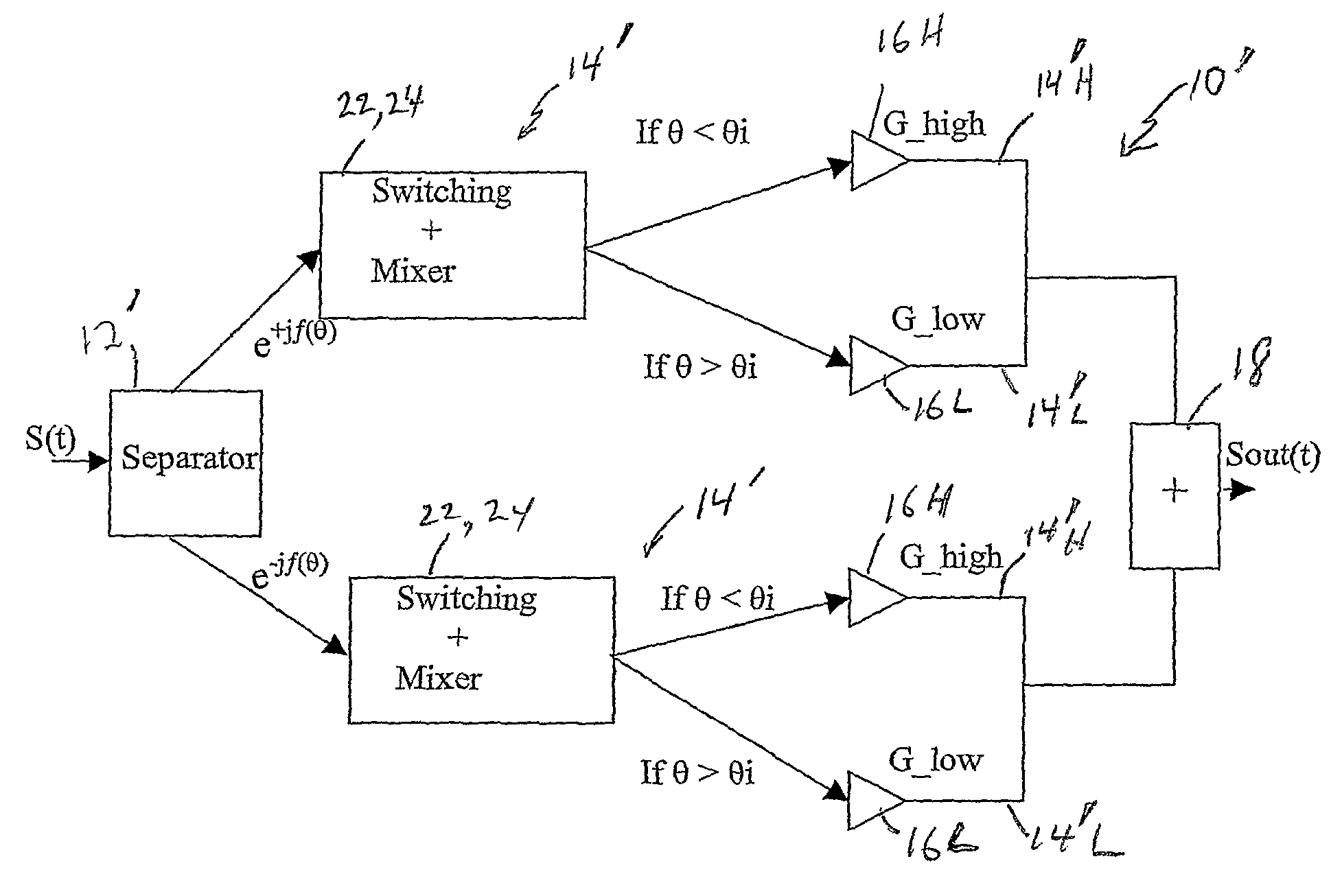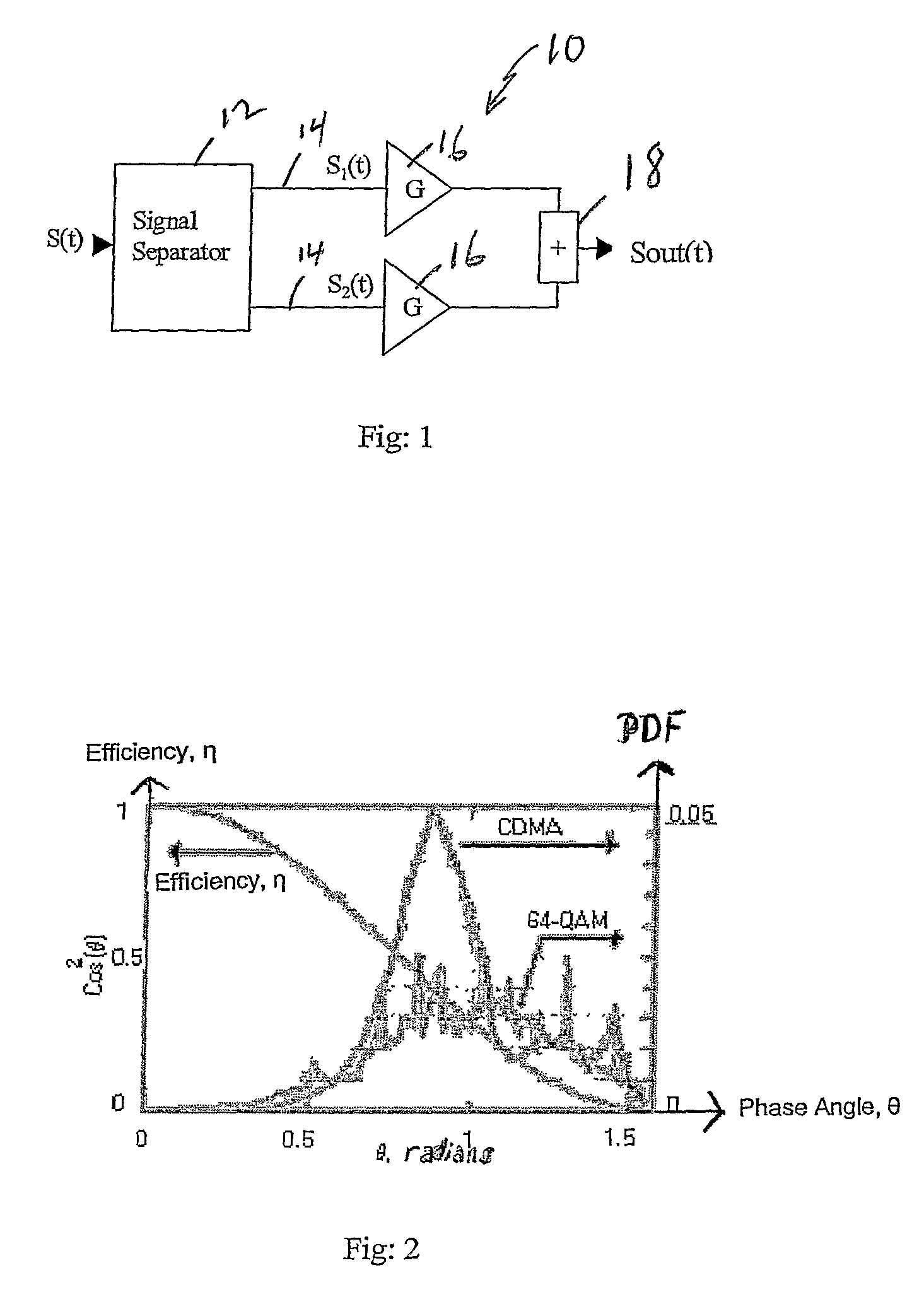High efficiency RF transmitter system using non-linear amplifiers
a non-linear amplifier and transmitter technology, applied in the field of transmitters, can solve the problems of limiting the efficiency of the transmitter to the inherent efficiency, no way to improve efficiency, and the greatest operating cost of the base station is the cost of the electrical energy consumed by the amplifier of the transmitter, so as to achieve good linearity and improve efficiency.
- Summary
- Abstract
- Description
- Claims
- Application Information
AI Technical Summary
Benefits of technology
Problems solved by technology
Method used
Image
Examples
second embodiment
[0085]the present invention does not use an additional stage or stages of amplifiers and associated branches. It uses only two non-Ainear RF amplifiers. Each RF amplifier is used in one branch; consequently there are only two branches (FIG. 1) as in the classic UINC structure. The decomposition of signal, however, is not the same as that developed in the classic LINC. The two RF amplifiers 16, 16 are operated generally at high efficiency (class B, C, . . . ), characterized by a non-constant power gain, and with non-linearity at output.
[0086]This invention uses each RF amplifier 16, 16 in its non-linear operation zone. The power output of a suitable RF amplifier with Class F as a function of input power to the amplifier is shown in FIG. 9.
[0087]In a first operating zone, from where the output power where the amplifier is highly efficient to some dB of back off, the decomposition of the input signal S(t) by the separator 12 operates to separate the input signal S into two identical si...
embodiment 2
[0098]The third solution or embodiment of this invention applies the two solutions 1 and 2 described above simultaneously. That means, in the multistage solution (FIG. 7) each RF amplifier 16H, 16L(1) . . . 16L(n−1) is used with a non-constant envelope, instead of a constant envelope. In the multi-stage RF amplifiers with G_high, G_low_i (i=1 to n−1), one applies the second solution in the condition 0—1) one applies the second solution completely, i.e. one considers the second part of signals described above with respect to solution /
[0099]The new average efficiency ηavg is:
[0100]ηAve=ηhigh∑θk<θ1[Idchigh_maxIdchigh_k]Cos2(θk)pk+∑i=1n-1ηlow_i[∑θi+1>θj>θi[Idclow_i_maxIdclow_i_k]pj·Cos2(θj)]+ηlow_n[∑90>θj>θnpj·Cos2(θj)](25)
[0101]In this embodiment, one can optimize (25) to find a best value of θi i=1 to n to obtain a best efficiency.
[0102]Using an RF transmitter according to the present invention, one can achieve a signific...
PUM
 Login to View More
Login to View More Abstract
Description
Claims
Application Information
 Login to View More
Login to View More - R&D
- Intellectual Property
- Life Sciences
- Materials
- Tech Scout
- Unparalleled Data Quality
- Higher Quality Content
- 60% Fewer Hallucinations
Browse by: Latest US Patents, China's latest patents, Technical Efficacy Thesaurus, Application Domain, Technology Topic, Popular Technical Reports.
© 2025 PatSnap. All rights reserved.Legal|Privacy policy|Modern Slavery Act Transparency Statement|Sitemap|About US| Contact US: help@patsnap.com



